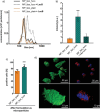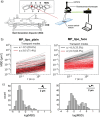Nano-in-Microparticles for Aerosol Delivery of Antibiotic-Loaded, Fucose-Derivatized, and Macrophage-Targeted Liposomes to Combat Mycobacterial Infections: In Vitro Deposition, Pulmonary Barrier Interactions, and Targeted Delivery
- PMID: 35112802
- PMCID: PMC11468583
- DOI: 10.1002/adhm.202102117
Nano-in-Microparticles for Aerosol Delivery of Antibiotic-Loaded, Fucose-Derivatized, and Macrophage-Targeted Liposomes to Combat Mycobacterial Infections: In Vitro Deposition, Pulmonary Barrier Interactions, and Targeted Delivery
Abstract
Nontuberculous mycobacterial infections rapidly emerge and demand potent medications to cope with resistance. In this context, targeted loco-regional delivery of aerosol medicines to the lungs is an advantage. However, sufficient antibiotic delivery requires engineered aerosols for optimized deposition. Here, the effect of bedaquiline-encapsulating fucosylated versus nonfucosylated liposomes on cellular uptake and delivery is investigated. Notably, this comparison includes critical parameters for pulmonary delivery, i.e., aerosol deposition and the noncellular barriers of pulmonary surfactant (PS) and mucus. Targeting increases liposomal uptake into THP-1 cells as well as peripheral blood monocyte- and lung-tissue derived macrophages. Aerosol deposition in the presence of PS, however, masks the effect of active targeting. PS alters antibiotic release that depends on the drug's hydrophobicity, while mucus reduces the mobility of nontargeted more than fucosylated liposomes. Dry-powder microparticles of spray-dried bedaquiline-loaded liposomes display a high fine particle fraction of >70%, as well as preserved liposomal integrity and targeting function. The antibiotic effect is maintained when deposited as powder aerosol on cultured Mycobacterium abscessus. When treating M. abscessus infected THP-1 cells, the fucosylated variant enabled enhanced bacterial killing, thus opening up a clear perspective for the improved treatment of nontuberculous mycobacterial infections.
Keywords: air-liquid interfaces; bedaquiline; liposomal dry powders; particle tracking; pulmonary surfactants.
© 2022 The Authors. Advanced Healthcare Materials published by Wiley-VCH GmbH.
Conflict of interest statement
The authors declare no conflict of interest.
Figures










Similar articles
-
Dry powder inhalation containing muco-inert ciprofloxacin and colistin co-loaded liposomes for pulmonary P. Aeruginosa biofilm eradication.Int J Pharm. 2024 Jun 10;658:124208. doi: 10.1016/j.ijpharm.2024.124208. Epub 2024 May 7. Int J Pharm. 2024. PMID: 38723731
-
Advanced spray-dried design, physicochemical characterization, and aerosol dispersion performance of vancomycin and clarithromycin multifunctional controlled release particles for targeted respiratory delivery as dry powder inhalation aerosols.Int J Pharm. 2013 Oct 15;455(1-2):374-92. doi: 10.1016/j.ijpharm.2013.06.047. Epub 2013 Jun 29. Int J Pharm. 2013. PMID: 23820131
-
Physicochemical characterization and aerosol dispersion performance of organic solution advanced spray-dried microparticulate/nanoparticulate antibiotic dry powders of tobramycin and azithromycin for pulmonary inhalation aerosol delivery.Eur J Pharm Sci. 2014 Feb 14;52:191-205. doi: 10.1016/j.ejps.2013.10.016. Epub 2013 Nov 9. Eur J Pharm Sci. 2014. PMID: 24215736
-
Therapeutic liposomal dry powder inhalation aerosols for targeted lung delivery.Lung. 2012 Jun;190(3):251-62. doi: 10.1007/s00408-011-9360-x. Epub 2012 Jan 25. Lung. 2012. PMID: 22274758 Review.
-
A Review on Micro and Nanoengineering in Powder-Based Pulmonary Drug Delivery.Int J Pharm. 2024 Jun 25;659:124248. doi: 10.1016/j.ijpharm.2024.124248. Epub 2024 May 21. Int J Pharm. 2024. PMID: 38782150 Review.
Cited by
-
Nanosized Drug Delivery Systems to Fight Tuberculosis.Pharmaceutics. 2023 Jan 24;15(2):393. doi: 10.3390/pharmaceutics15020393. Pharmaceutics. 2023. PMID: 36839715 Free PMC article. Review.
-
Opportunities and Challenges for Inhalable Nanomedicine Formulations in Respiratory Diseases: A Review.Int J Nanomedicine. 2024 Feb 17;19:1509-1538. doi: 10.2147/IJN.S446919. eCollection 2024. Int J Nanomedicine. 2024. PMID: 38384321 Free PMC article. Review.
-
Intranasal Administration of Bedaquiline-Loaded Fucosylated Liposomes Provides Anti-Tubercular Activity while Reducing the Potential for Systemic Side Effects.ACS Infect Dis. 2024 Sep 13;10(9):3222-3232. doi: 10.1021/acsinfecdis.4c00192. Epub 2024 Aug 13. ACS Infect Dis. 2024. PMID: 39136125 Free PMC article.
-
State-of-the-Art Review on Inhalable Lipid and Polymer Nanocarriers: Design and Development Perspectives.Pharmaceutics. 2024 Mar 1;16(3):347. doi: 10.3390/pharmaceutics16030347. Pharmaceutics. 2024. PMID: 38543241 Free PMC article. Review.
-
Treatment of lung diseases via nanoparticles and nanorobots: Are these viable alternatives to overcome current treatments?Mater Today Bio. 2025 Feb 26;31:101616. doi: 10.1016/j.mtbio.2025.101616. eCollection 2025 Apr. Mater Today Bio. 2025. PMID: 40124344 Free PMC article. Review.
References
-
- Menina S., Eisenbeis J., Kamal M. A. M., Koch M., Bischoff M., Gordon S., Loretz B., Lehr C.‐M., Adv. Healthcare Mater. 2019, 8, 1900564. - PubMed
-
- Laudon M., Romanowicz B., 11th Annual TechConnect World Innovation Conference & Expo, May 14–17, 2017.
-
- Muttil P., Wang C., Hickey A. J., Pharm. Res. 2009, 26, 2401. - PubMed
Publication types
MeSH terms
Substances
LinkOut - more resources
Full Text Sources
Other Literature Sources
Medical

